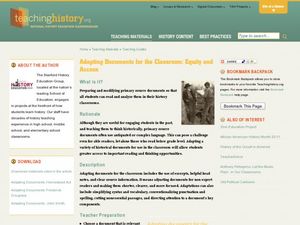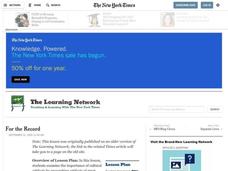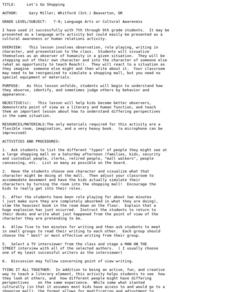Curated OER
The Scoop on Local Business
How do local businesses support their state or regional economy? The New York Times has prepared another great lesson for your class. They begin by listing products grown or manufactured in their state or region then write interview...
Curated OER
Validating Votes
Explore the discrepancies in Florida's vote counting process in 2000 and 2002 with this New York Times reading lesson plan. Middle schoolers study the viewpoints presented in informational text, paying attention to how word choice...
Curated OER
Scientific Scenes
Students discover how the public's perceptions of science have changed throughout recent history; then research scientific and technological breakthroughs in a variety of areas. They then create plays that allow scientists to encounter...
Curated OER
Mark Twain- Teaching About American Authors
Mark Twain lesson plans can shed light on his famous works, like "The Adventures of Tom Sawyer."
Curated OER
Proper Perspective
Students consider what makes a famous painting realistic, then examine a theoretical debate about how Renaissance masters created their true-to-life images. They create their own realistic drawings.
Curated OER
Re-Viewpoints From 2002
Students explore how editorials use various devices to convey a message to a reader. They select key news topics from 2002 and write their own editorials.
Curated OER
From Whose Perspective?
Students critically analyze news coverage of Palestinian-Israeli violence by comparing information from a variety of news sources. They compose expository essays reflecting on how to obtain accurate, unbiased, and credible information.
Curated OER
Perspectives from the Present
Students use the Learning Network's '1999 Year in Review Quiz' to revisit significant news events and examine the impact these news events had. They create their own quizzes based on news topics of their choice.
Curated OER
Poll-icy Perceptions
Students create their own opinion polls about local policy issues. They evaluate how anonymity may affect responses. In groups, students experience the process of developing polls, focusing on student-related topics. Students must...
Curated OER
Adapting Documents for the Classroom: Equity and Access
Students examine primary sources to gain historical perspectives. In this historical analysis instructional activity, students analyze documents that their instructors have adapted to make more user-friendly. Example adapted primary...
Curated OER
Rediscovering Forgotten Women Writers
Women's voices are becoming more prominent in the world of literature, but for centuries, this wasn't the case. Young historians research a woman whose writings are considered to be lost, out of print, or forgotten. They develop an oral...
Curated OER
For the Record
Students read a New York Times article in order to examine the importance of cultural artifacts. They create essays from the point of view of one cultural artifact to demonstrate the knowledge they gained by doing research.
Shmoop
ELA.CCSS.ELA-Literacy.RI.9-10.8
Your learners need to develop skills to argue effectively, and this comes by understanding the traditions that make claims valid, and what detracts from their effectiveness. Although this resource does not give advice on how to...
Curated OER
Let's Go Shopping
Students explore how to become better observers, demonstrate point of view as a literary and human function, and learn an important lesson about how to explain differing perspectives in the same situation.
Curated OER
Women
A close study of two works of art provides the introduction to this cross-curricular writing assignment. After comparing the clothing, facial expressions, body language, setting, and color in the two 19th century paintings Tissout’s...
Curated OER
As the Kids Come and Go: Mapping a Classroom
Map the classroom with your kids to help them understand how maps work and how to read them. The lesson starts off with a story about animals living and moving around the globe, and then kids create maps of their classroom to show how...
Curated OER
A MATTER OF PERSPECTIVE: COLUMBUS IN THE NEW WORLD
Eighth graders study the famous explorer Christopher Columbus. In this World History lesson, 8th graders analyze and compare primary and secondary sources. Students discuss as a class the accomplishments of Columbus....
Curated OER
Using History to Teach Tolerance: A Ripple of Hope
Students investigate the prejudice and racism that has existed in the U.S. for centuries by attending a field trip. In this equality lesson, students visit the Tolerance Museum and discuss the history of the U.S. Students...
New York City Department of Education
What Did I Do to Be so Black and Blue: How Did Jazz Influence Ralph Ellison's Invisible Man
How did jazz influence Ralph Ellison's Invisible Man? Class members read some of Ellison's non-fiction writings about blues and jazz, listen to records, watch videos, and engage in student-centered discussions. They then produce podcasts...
Curated OER
The Object Is Objectivity
Students search for and read articles about the initial United States strike on Afghanistan from non-U.S. news sources, then describe the journalists' perspectives and reflect on how difficult it might be to maintain an objective wartime...
Curated OER
PERCEIVINGT A CULTURE THROUGH ITS LITERATURE
Studentsexamine cultural values in literature, identify the cultural assumptions, prejudices, and purposes of authors and translators, use historical perspective to determine if the values and lifestyle depicted apply to contemporary...
Curated OER
Muddle East
Students explore the conflict between Israel and Hezbollah. They research various perspectives, discuss the events in context, and write statements from the perspective of a country or organization involved.
Curated OER
This Land Is… Whose Land?
Students examine the territorial issues and perspectives surrounding the Israeli-Palestinian conflict. They create an outline and point-counterpoint essay illustrating the perspectives surround the Israeli land dispute with the...
Curated OER
Popularity, Publicity, and Public Service
Students discuss the issue of celebritites who speak out for certain diseases. After reading an article, they consider a doctor's perspective on the use of celebrities. In groups, they research a common disease and design a public...

























